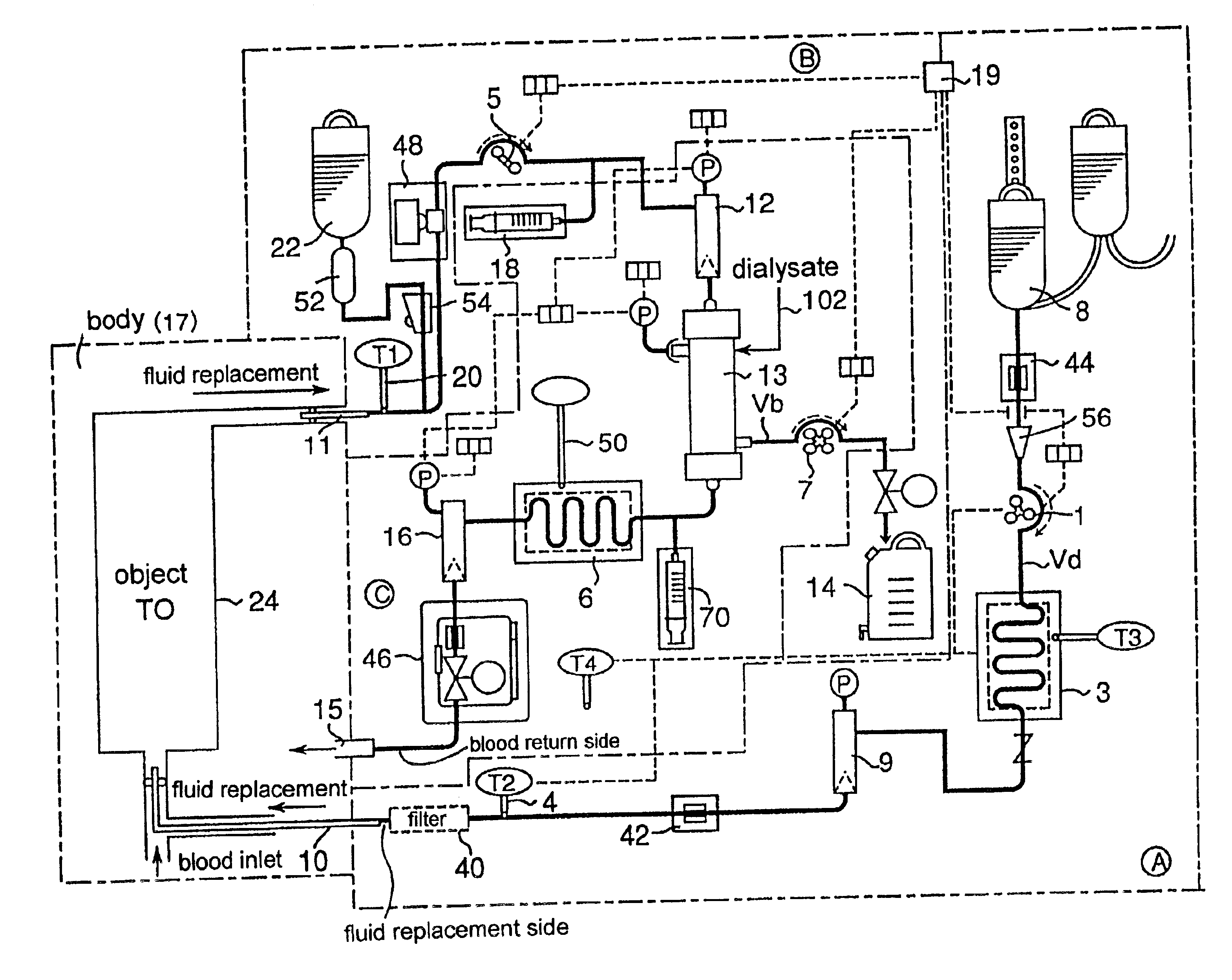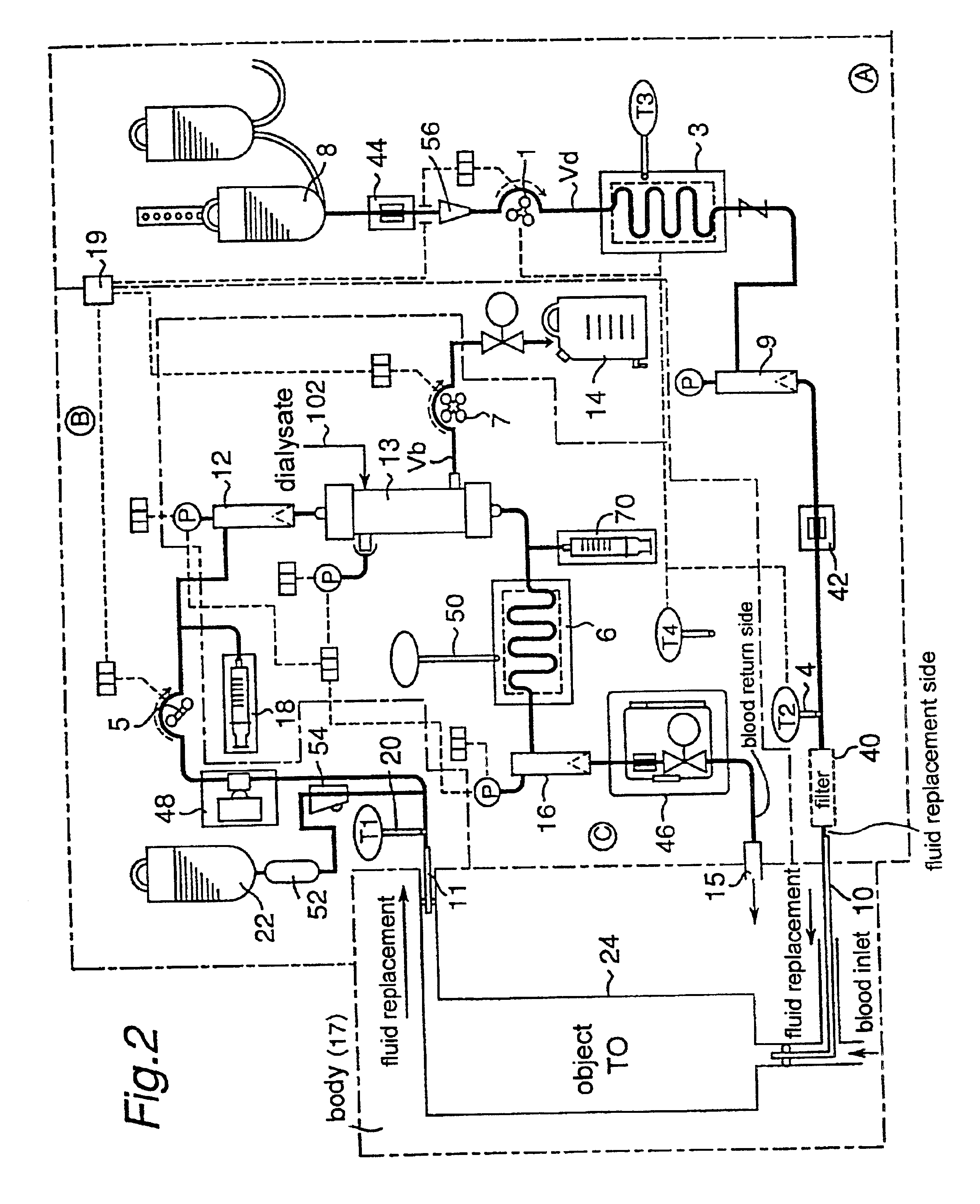Bloodless treating apparatus
a treatment apparatus and bloodless technology, applied in the direction of suction devices, other blood circulation devices, medical devices, etc., can solve the problems of failure of treatment, inability to avoid bleeding, and reduce the pressure of patients, so as to reduce the amount of bleeding, the effect of substantially reducing the amount of bleeding
- Summary
- Abstract
- Description
- Claims
- Application Information
AI Technical Summary
Benefits of technology
Problems solved by technology
Method used
Image
Examples
case 1
Fluid replacement is charged beforehand from a fluid replacement bottle (22) into the elements and the conduits in the apparatus. First, a predetermined temperature (T0) to which the object is controlled and operation conditions such as a supplied fluid replacement rate, a withdrawn fluid replacement rate and so on are determined depending on an object (24) to which the surgical treatment is applied and the treatment for the object. Then, a heat exchanger (3) is operated, and its adjusting temperature (T3) is set at for example the predetermined temperature (T0). Upon this, the adjusting temperature (T3) may be shifted a little from the predetermined temperature (T0) considering the heat absorption or heat loss after leaving the heat exchanger (3) until entering the body (namely, ΔT) as well as the temperature change after entering the body until reaching the object.
Each catheter is inserted into the blood vessel, and the pump (1) is operated and the fluid replacement is supplied fr...
case 2
Although in Case 1, only the withdrawn fluid replacement temperature (T1) is taken into account, the supplied fluid replacement temperature (T2) is also considered in addition to the withdrawn fluid replacement temperature (T1) in Case 2. In this case, the averaged temperature Tav of T1 and T2 (=(T1+T2) / 2) may be regarded to indicate the actual temperature of the object (T0), and this case is generally superior in the estimation of the object temperature to Case 1 wherein only T1 is considered. Similarly to Case 1 described above, the different extent between the averaged temperature (Tav) and the predetermined temperature of the object region (T0), for example the difference ΔTb (=(T1−T2) / 2−T0) is obtained. The others are substantially the same as those in Case 1. It is noted that T1 and T2 have the same weight in this case so as to obtain the averaged value, but it may be possible optionally to change their weights. For example, it is possible to use 1.5×T1 in place of T1, and 0.5...
case 3
Temperature adjustment of the heat exchanger (3) may be carried out in various appropriate manners depending on the different extent, for example the value of the difference ΔTa or ΔTb.
For example, when the difference ΔTa is positive in Case 1, the set temperature of the heat exchanger (3) is operated to be lowered so that the withdrawn fluid replacement temperature (T1) is decreased. When the difference ΔTa is negative, the opposite operation is carried out. Upon these operations, it is preferable to consider a static characteristic and / or a dynamic characteristic of the difference ΔTa.
For example, when the difference ΔTb is positive in Case 2, the set temperature of the heat exchanger (3) is operated to be lowered so that the supplied fluid replacement temperature (T2) is decreased. Upon this operation, considering that the difference ΔTb desirably becomes zero, T2 is calculated from the predetermined temperature (T0) and the measured withdrawn fluid replacement temperature throug...
PUM
 Login to View More
Login to View More Abstract
Description
Claims
Application Information
 Login to View More
Login to View More - R&D
- Intellectual Property
- Life Sciences
- Materials
- Tech Scout
- Unparalleled Data Quality
- Higher Quality Content
- 60% Fewer Hallucinations
Browse by: Latest US Patents, China's latest patents, Technical Efficacy Thesaurus, Application Domain, Technology Topic, Popular Technical Reports.
© 2025 PatSnap. All rights reserved.Legal|Privacy policy|Modern Slavery Act Transparency Statement|Sitemap|About US| Contact US: help@patsnap.com



